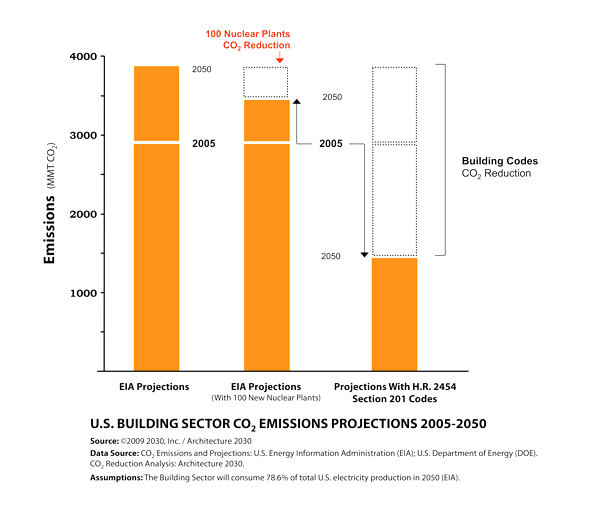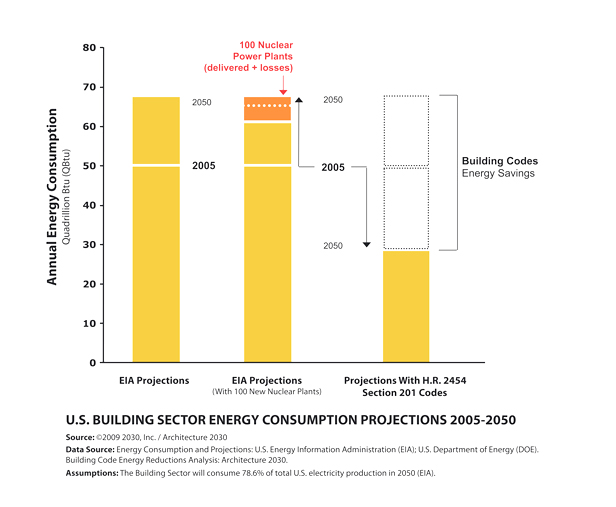 Building energy codes are the key.Are 100 new nuclear plants the solution to our climate troubles? I asked that question in a post last week.
Building energy codes are the key.Are 100 new nuclear plants the solution to our climate troubles? I asked that question in a post last week.
The answer lies buried deep within the 1,428-page Waxman-Markey climate bill (H.R. 2454, the American Clean Energy and Security Act), passed by the House and now under consideration in the Senate. It is Section 201, pages 320-348. It is this section that makes H.R. 2454 worth passing.
No matter what else is compromised or changed in the climate bill as it works its way through the Senate, Section 201 must not be changed or weakened. Why? Because all other energy- and emissions-reduction approaches pale in comparison to what Section 201 will accomplish. Without it, we simply cannot meet the greenhouse gas (GHG) emissions reduction targets called for in the bill. We won’t even come close.
Section 201 covers building energy codes — that’s right, building energy codes — that will transform the entire built environment in the U.S. by 2050. That’s because Section 201 affects all new buildings and major renovations, and by 2050 more than three-quarters of the built environment in the U.S. will be either new or renovated.
Section 201 requires updating national building energy codes to meet the following energy reduction targets:
- in 2010, 30% below the baseline energy code (IECC 2006 and ASHRAE 90.1-2004),
- in 2014-2015, 50% below the baseline energy code, and
- every three years after, out to 2029-2030, an additional 5% reduction.
The targets outlined in Section 201 are simply more effective than any other energy and emissions reduction approach. The following graphs compare Section 201 with the call by some in Congress for a massive U.S. effort to build 100 new nuclear power plants in an attempt to move the country toward energy independence and significant GHG emissions reductions:
 The proof is in the data. There’s simply no comparison. Whereas the 100 nuclear power plants only act as a replacement energy source, the updated building energy codes of Section 201 actually reduce energy consumption, eliminating the need for more plants. The codes also achieve more than six times the emissions reductions of 100 nuclear power plants. The codes accomplish all of this at a fraction of the cost. Here are the facts:
The proof is in the data. There’s simply no comparison. Whereas the 100 nuclear power plants only act as a replacement energy source, the updated building energy codes of Section 201 actually reduce energy consumption, eliminating the need for more plants. The codes also achieve more than six times the emissions reductions of 100 nuclear power plants. The codes accomplish all of this at a fraction of the cost. Here are the facts:
- Since June 2006, over 60,000 new homes have been designed, built, and certified to meet a minimum 50% energy reduction below the baseline energy code for heating and cooling.
- Studies by the Department of Energy’s National Renewable Energy Laboratory (NREL) illustrate that meeting a 30% residential energy consumption reduction target below code will save households in every region of the U.S. between $403 and $612 per year after the cost of efficiency measures is factored in.
- At current energy prices and mortgage interest rates, NREL estimates that the average cost-neutral point for home efficiency upgrades is a 45% energy reduction below code.
The targets in Section 201 are set at a reasonable and beneficial pace for change that will achieve the reductions necessary within the timeline called for by the scientific community. Implementing these targets will reduce building sector energy consumption by:
- 18.35 Quadrillion Btus from projected 2030 levels (the equivalent of approximately two hundred and forty 1000-MW power plants), saving consumers an estimated $218 billion in annual energy bills (2007 dollars),
- 18.7% below 2005 levels by 2030, and
- 40.4% below 2005 levels by 2050.
Implementing the targets in Section 201 would also reduce building sector CO2 emissions by:
- 20.3% below 2005 levels by 2030 and
- 48.8% below 2005 levels by 2050, leaving only 34% of President Obama’s 83% Building Sector reduction target to be accomplished with other clean energy sources.
It is clear that the building energy code targets set in Section 201 are not only essential for achieving the energy consumption and GHG emissions reductions needed, but they are also the most cost-effective approach for doing so.
What about China and India? The U.S., through our multi-national architecture and engineering design firms, heavily influence the global built environment. As our firms move the U.S. built environment into the 21st century, they will, in both practice and influence, move China’s and India’s as well (see a list of multi-state and national firms that have adopted the 2030 Challenge in Appendix B of the Architecture 2030 Fact Sheet [PDF]).
To read Architecture 2030’s complete analysis of H.R. 2454, Section 201, with sources and citations, download the Architecture 2030 Fact Sheet [PDF].




